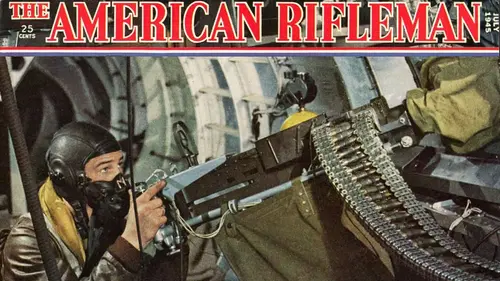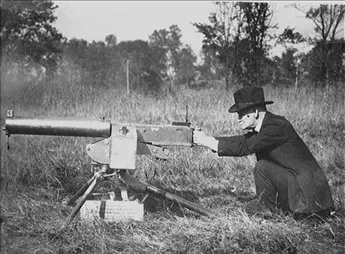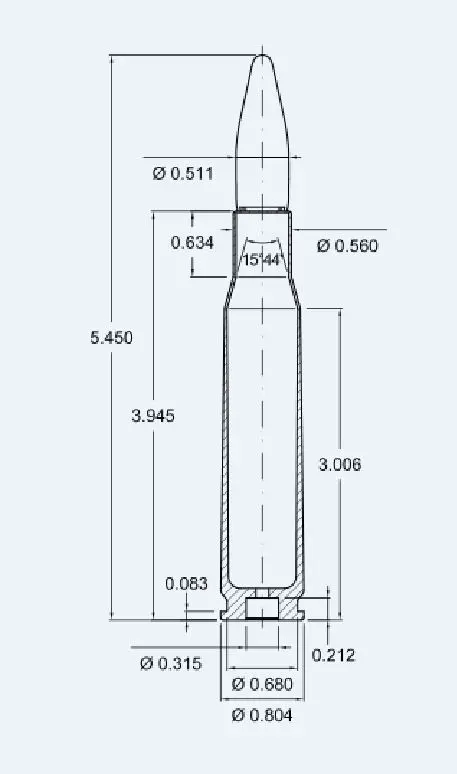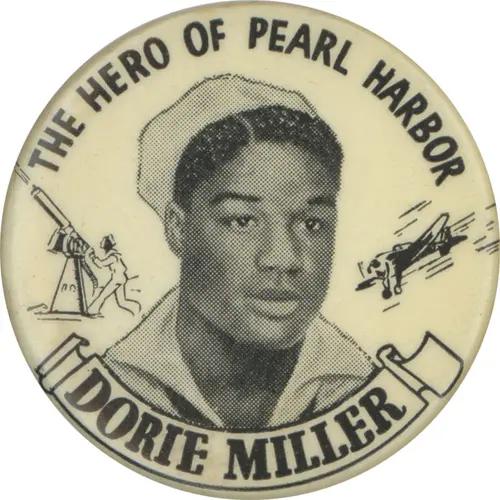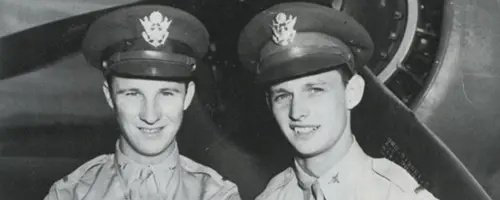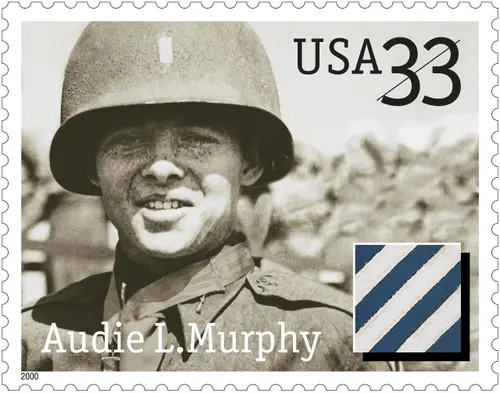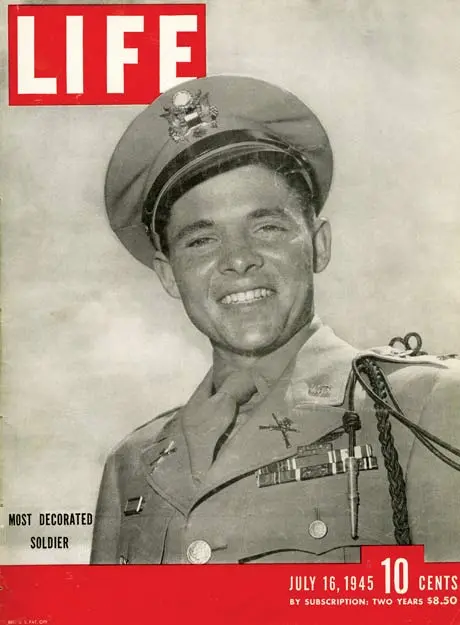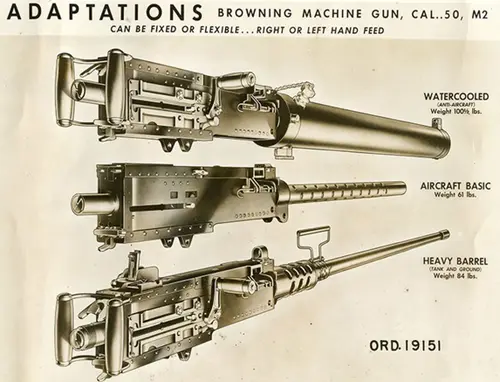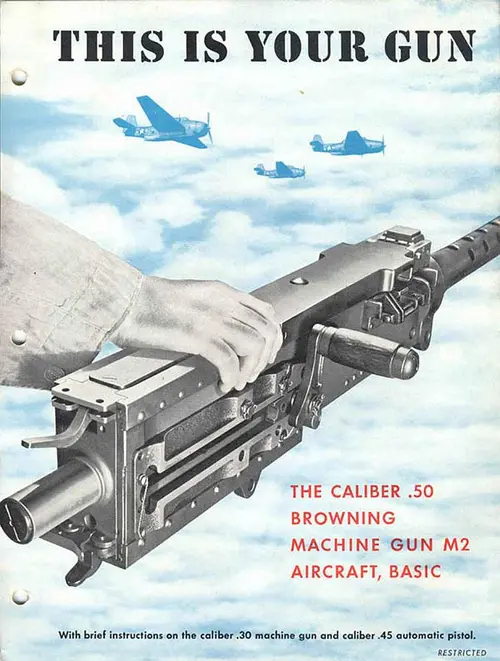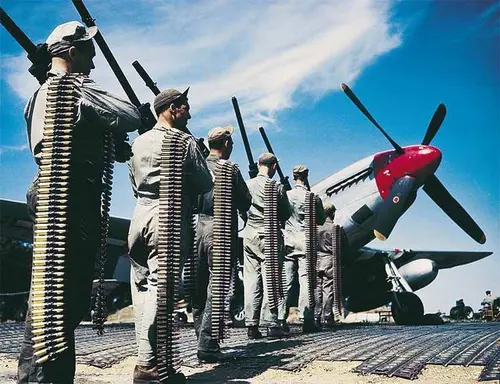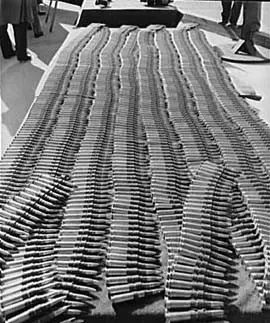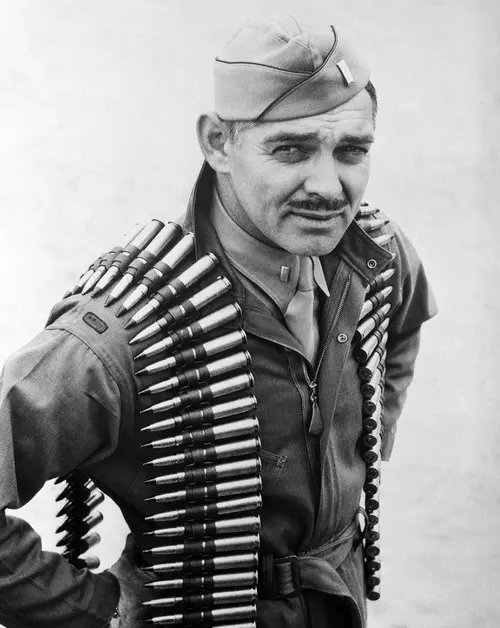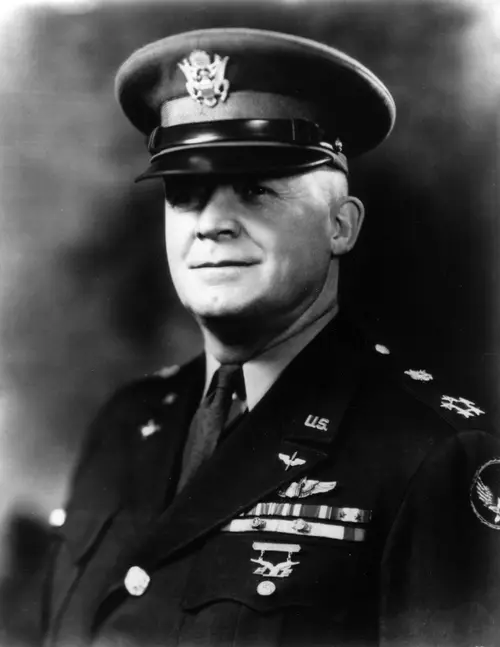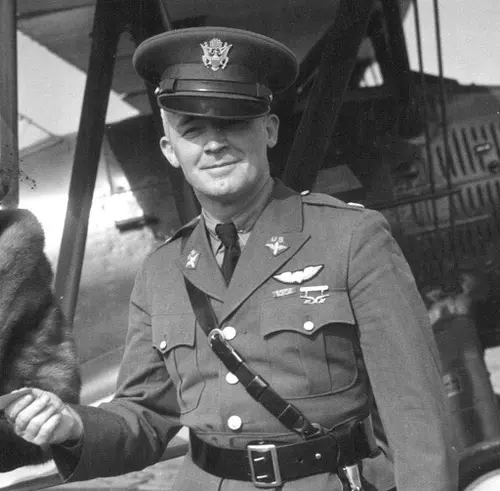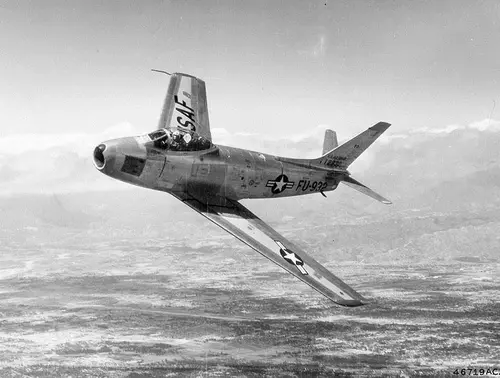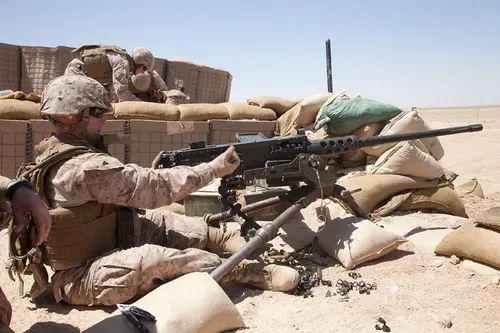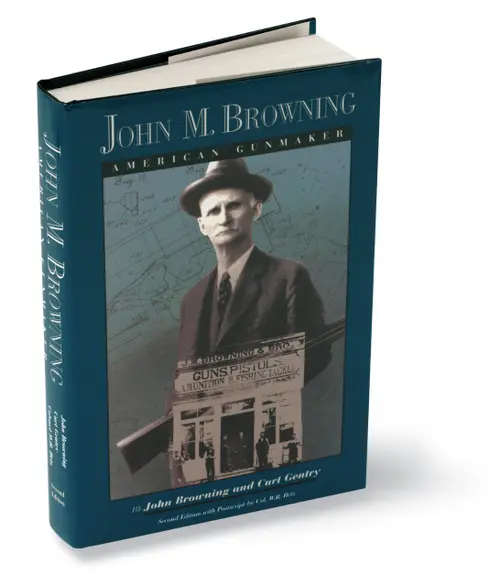A close look at the .50 BMG and the M2 machine gun.
A close look at the .50 BMG and the M2 machine gun.
A review of the fine article by Barrett Tillman titled: The .50-cal Browning Machine Gun - The Gun That Won the War.
A review of the fine article by Barrett Tillman titled: The .50-cal Browning Machine Gun - The Gun That Won the War.
In the world of military firearms, many designs come and go. Most last only a few years, or perhaps a decade or two before being replaced by something “new and improved.”
However, when it comes to the firearm designs of the legendary John M. Browning, they tend to remain in active service for many decades. Several in fact are well into their second century. One of his most enduring and effective designs is the heavy machine gun that proudly bears his name, the awesome .50 Browning – also known to millions of servicemen and women as the “Browning M2” or simply the “Ma Deuce.”
The Browning .50 caliber was on the cover of the July 1945 issue of The American Rifleman, as WWII drew to a close. NRA photo.
John M. Browning personally tests an early prototype of his water-cooled .50 caliber heavy machine gun in Colt’s pasture in the closing days of WWI. It’s said the .50 caliber project was requested by General Pershing as an early anti-tank weapon. Browning archives photo.
Though Browning died in 1926, he provided his nation with nearly all its World War II machine guns, its automatic rifle and its foremost sidearm.
Though Browning died in 1926, he provided his nation with nearly all its World War II machine guns, its automatic rifle and its foremost sidearm.
The March 2017 issue of the NRA American Rifleman features an outstanding article by the noted gunwriter and military historian Barrett Tillman on the origin, evolution and current service of that big booming Browning that, as Tillman notes, is “The Gun That Won The War.”
“John M. Browning was a historic figure whose guns…helped end WWII,” Tillman observes. “…Though Browning died in 1926, he provided his nation with nearly all its World War II machine guns, its automatic rifle and its foremost sidearm. But he did something even grander. Browning’s magnificent M2 machine gun—chambered in the .50 Browning Machine Gun (BMG) cartridge—gave America and her allies the priceless gift of global air superiority. Nothing else came close.”
“American interest in an armor-piercing cartridge … (prompted) U.S. Army Ordnance officers to consult Browning,” noted Tillman. “They wanted a heavy projectile at 2700 feet per second (f.p.s.), but the ammunition did not exist. Browning pondered the situation and, according to his son John, replied, ‘Well, the cartridge sounds pretty good to start. You make up some cartridges and we’ll do some shooting.’ Ordnance contracted with Winchester to design a .50-cal. cartridge. Subsequently, Frankford Arsenal took over from Winchester, producing the historic .50 BMG or 12.7x99 mm cartridge. The Army then returned to John Browning for the actual gun. Teamed with Colt, he produced prototypes ready for testing and, ironically, completed them by Nov. 11, 1918—the Great War’s end.”
Navy Cross recipient Messman Third Class Doris “Dorie” Miller.
After further development by John M. Browning in the immediate post WWI-era, the resulting gun was approved for production and called the M1921 water-cooled .50-cal. machine gun, and it formed the basis for today’s M2 model, the fabled “Ma Deuce.” While the water-cooled model was ideal for fixed ground mounts, anti-aircraft batteries and shipboard use, the infantry needed a more portable solution, and thus the M2 HB model soon came to be.
As America was suddenly thrust into the chaos of WWII in the early hours of December 7, 1941, those Big Brownings in the hands of our nations warriors were hammering away at the enemy from the very first minutes of the fight.
Among those behind a Browning .50 that tragic December morning were Medal of Honor winner CPO John Finn and Navy Cross recipient Messman Third Class Doris “Dorie” Miller, both of the U.S. Navy.
The Browning .50 caliber was on the cover of the July 1945 issue of The American Rifleman, as WWII drew to a close. NRA photo.
A pair of Army Air Corps pilots, 2LTs George S. Welch and Kenneth Taylor roared aloft to meet the attacking enemy in their Curtis P40 Tomahawk fighters. With their planes’ multiple Browning machine guns ablaze, the pair accounted for seven enemy fighters that day and both received the Distinguished Service Cross.
“Undoubtedly the best-known M2 engagement occurred on the other side of the world…” Tillman recounts. “In France on Jan. 26, 1945, 19-year-old 2nd Lt. Audie Murphy climbed aboard a burning tank destroyer to man the .50 as a company of German infantry advanced. Though hit in one leg, he remained at the gun, shooting down perhaps 50 of the enemy before running dry. Then he returned to his platoon to organize a counterattack. For this, Murphy received the Medal of Honor, and he would become one of the most decorated soldiers in American military history.”
Pick your favorite .50 caliber flavor. NRA photo.
Cover of a WWII-era US military technical manual on the Browning M2 intended for combat aircrews.
“With a global need, it seemed that everyone built M2s, from AC Spark Plug Co. to Frigidaire to Guide Lamp,” Tillman explained. “American Rifleman Field Editor Bruce Canfield’s encyclopedic U.S. Infantry Weapons of World War II shows nearly 350,000 M2 Heavy Barrels (M2HB) produced among nearly 2,000,000 .50 calibers of all models during the war years. Everybody wanted the Ma Deuce in .50 BMG for its fabled power, range and reliability.”
US Army Air Forces armorers bring a half dozen .50 caliber Brownings and numerous belts of ammo out to the flight line to arm a P-51 Mustang during WWII.
"The outstanding aircraft gun of the Second World War.’
"The outstanding aircraft gun of the Second World War.’
Yes, the .50 caliber Browning was deployed just about everywhere during WWII, and they consumed billions of rounds of ammo during the course of the conflict.
An American B-25 Mitchell with eight forward-firing Browning .50s gets a last-minute check by the plane’s armorer before going aloft to confront the enemy. NRA photo.
Commanding General of the U.S. Army Air Forces Henry H. "Hap" Arnold personally offered the movie star Clark Gable a "special assignment" in aerial gunnery during the war. Shown with a belt of 50s over his shoulders.
Virtually every US and Allied combat aircraft, naval ship, armored vehicle and infantry unit was equipped with big Browning bruisers. Some aircraft, like the heavy bombers and dedicated ground attack planes might sport up to a dozen .50s in both fixed and flexible mounts.
Gen. Henry ‘Hap’ Arnold, chief of the US Army Air Forces. USAF photo.
“…If the German Air Force had the Browning .50 caliber, the Battle of Britain would have turned out differently.”
“…If the German Air Force had the Browning .50 caliber, the Battle of Britain would have turned out differently.”
“The AN/M2 was fully appreciated by the war’s midpoint,” explained Tillman. “In 1943, Gen. Henry ‘Hap’ Arnold, chief of the Army Air Forces, declared the Browning ‘…the outstanding aircraft gun of the Second World War.’ He added, ‘This weapon … is the backbone of offensive and defensive gun [sic] for American aircraft and was brought to such a state of perfection by the Ordnance Department during the years of peace prior to the present conflict that it has enabled the Army Air Forces, the U.S. Navy and Marine Corps to show a definite superiority in aircraft gun power through this global war.’ ”
Gen. Henry ‘Hap’ Arnold in his younger years.
The enemy also had similar feelings about the big Browning. Field Marshall Hermann Göring, head of the German Luftwaffe during WWII reported once wrote “…If the German Air Force had the Browning .50 caliber, the Battle of Britain would have turned out differently.”
The legendary F-86 Saber fighter had a half dozen forward-firing .50 Brownings in its nose.
“Longevity remains a hallmark of John M. Browning’s designs,”
“Longevity remains a hallmark of John M. Browning’s designs,”
WWII by no means ended the Browning .50s career. The rate of fire on the venerable platform was boosted to well over 1000 rounds per minute and these guns armed the first generation of American fighters like the legendary F-86 Saber dueling with Communist MiGs during the Korean War.
“Longevity remains a hallmark of John M. Browning’s designs,” Tillman concludes. “His timeless M1911 pistol is more widely used today than ever, and ‘Ma Deuce,’ dating from 1921, shows no signs of retiring. In fact, in 2015 the 324th M2 ever produced was finally removed from service—after 94 years in the inventory. The old warhorse was being retired because current standards would require extensive modification. Army Materiel Command quoted an armorer at Anniston Army Depot who said, ‘Looking at the receiver, for its age, it looks good as new and it gauges better than most of the other weapons.’ ”
Yes, you can expect to see the .50 Browning in front line combat service for many years to come.
Yes, the legendary warhorse still serves America. A Marine racks a round into his .50 caliber Browning M2HB on the training range at Camp Leatherneck in Helmand Province, Afghanistan. USMC/DOD photo.
You can read Barrett Tillman’s entire article on the Browning .50s in the March 2017 issue of NRA American Rifleman. It’s posted online at
Trivia for the day. The 50 caliber BMG is a popular Google search, sometimes spelled Fifty Caliber and other times 50 caliber machine gun. It seems much of this is driven by the newer class of long-range target rifles that use the John Browning-designed .50 caliber. Of all the searches on Google related to .50 calibers, one of the most popular is for the 50 caliber BMG bottle opener. It seems that if you can't own a Browning .50 machine gun like those shown above, at least you can open up some cool refreshment while reading this article. — The Editor
Original article copyright American Rifleman magazine, 2017. Review of the article, by Browning staff writer Scott Engen is copyright March 2017. Photos are in the pubic domain, from Browning archive photos, copyright American Rifleman or as indicated with the photo.
Born in 1855, John M. Browning dedicated his life to inventing revolutionary firearms that were desitned to shape the future. Read about him in this riveting biography. Click Here to buy the book.



